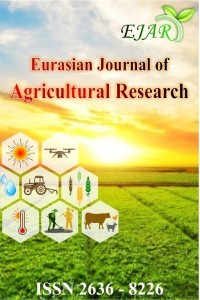Fahrurrozi FAHRURROZİ, Zainal MUKTAMAR, Sigit SUDJATMİKO, Nanik SETYOWATİ, Mohammad CHOZİN, Dia SARİ, Eny TOGATOROP
Comparative Performances of Organic and Inorganic Sweet Corn Grown on Coastal Land
Comparative Performances of Organic and Inorganic Sweet Corn Grown on Coastal Land
Coastal land serves as an alternative growing area for organic sweet corn production. Establishing an organic growing environment requires at least two years for short growing crop like sweet corn. This experiment aimed to evaluate the first year growth and yield performances of organic and conventional sweet corn production systems on coastal land. Experiment was conducted on entisol of coastal land from August to November 2019 at the City of Bengkulu and was arranged in a randomized complete block design with three replicates. Treatments were (1) organic production systems and (2) inorganic production systems. Sweet corn performances were observed in terms of plant weight, leaf number, leaf length, leaf greenness, shoot fresh weight, root fresh weight, root dry weight, level of sweetness, fresh weight of husked ear and fresh weight of unhusked ear. Results indicated that during the first year of organic production system for sweet corn, sweet corn grown in organic production system had similar plant weight, leaf number, leaf length, leaf greenness, shoot fresh weight, root fresh weight and root dry weight of sweet corn grown in inorganic production systems, except shoot dry weight. In addition, yield of organic sweet corn, as indicated by fresh weight of husked ear and fresh weight of unhusked ear, were 29 % and 23 %, respectively, lower than sweet corn grown in inorganic production system.
Keywords:
Organic Farming, Sweet Corn, Coastal Land,
___
- Ankamah-Yeboah I., Nielsen M. & Nielsen R. 2016: Price premium of organic salmon in Danish retail sale, Ecological Economics, 122, 54–60.
- Awal, M.A. 2014. Waterlogging in the southwestern coastal region of Bangladesh: local adaptation and policy options, Science Postprint, 1(1), e00038. http://dx.doi.org/10.14340/spp.2014.12A0001
- Brückler, M., Resl T. & Reindl, A. 2017. Comparison of organic and conventional crop yields in Austria, Die Bodenkultur: Journal of Land Management, food and Environment, 68(2), 223-236. http://dx.doi.org/10.1515/boku-2017-0018
- Davis, J. 2019. Organic Sweet Corn Production. Horticulture Information Leaflets, North Carolina State Extension Publications. https://content.ces.ncsu.edu/organic-sweet-corn-production
- Diaz, D.A.R., Sawyer, J.E. & Baker, D.W. 2012. Residual poultry manure N supply to corn the second and the third years application, Soil Science Society of American Journal, 76, 2289-2296.
- Fahrurrozi, F., Sariasih. Y., Muktamar, Z., Setyowati, N., Chozin, M. and Sudjatmiko, S. 2017. Identification of nutrients content in six potential green biomasses for developing liquid organic fertilizer in closed agricultural production system, International Journal Advanced Science, Engineering, Information Technology, 7(2), 559-565. Golijan, J. & Dimitrijevic, B. 2018. Global organic food market, Acta Agriculture of Serbia, 23:125-140.
- Hayati, M., Hayati, E. & Nurfandi, D. 2011. Pengaruh pupuk organik dan anorganik terhadap pertumbuhan beberapa varietas jagung manis di lahan Tsunami, Jurnal Floratek. 6:74-83.
- Indonesian National Standard. 2016. Organic Farming Systems, SNI 6729-2016. Indonesian Standardization Board. 54pp. Krause, J. & Machek, O. 2018. A comparative analysis of organic and conventional farmers in the Czech Republic, Agricultural Economic Czech, 64, 1–8. http://dx.doi.org/10.17221/161/2016-AGRICECON
- Muktamar, Z,. Sudjatmiko, S., Chozin, M., Setyowati, N. & Fahrurrozi, F. 2017. Sweet corn performance and its major nutrient uptake following application of vermicompost supplemented with liquid organic fertilizer, International Journal Advanced Science, Engineering, Information Technology, 7(2), 602-608.
- Murmu, K, Swain, D.K. & Ghosh, B.C. 2013. Comparative assessment of conventional and organic nutrient management on crop growth and yield and soil fertility in tomato-sweet corn production system, Australian Journal of Crop Science, 7(11), 1617-1626.
- Neeson, R. 2010. Organic vegetable production – soil management and crop establishment, Primefact 803. https://archive.dpi.nsw.gov.au/__data/assets/pdf_file/0020/353333/organic-vegetable-production-soil-management-and-crop-establishment.pdf
- Sari, D.P., Simanihuruk, B.W. & Gusmara, H. 2017. The effect of palm oil sludge and dosage of NPK fertilizer on growth and yield of sweet corn (Zea mays saccharata) in Ultisol, Agritrop, 15(1), 138-150.
- Singh, S.K., Yadav, R.B., Singh, J. & Singh, B. 2017. Organic Farming in Vegetables, IIVR Technical Report Bulletin no. 77. ICAR-IIVR, Varanasi. 47 pp https://www.iivr.org.in/sites/default/files/Technical%20Bulletins/Final%20Bulletin_77.pdf
- Sgroi F., Candela M., Di Trapani A.M., Fodera M., Squatrito R., Testa R. & Tudisca S. 2015. Economic and financial comparison between organic and conventional farming in Sicilian lemon orchards. Sustainability, 7, 947–961.
- Sofyan, E.T., & Sara, D.S. 2018. The effect of organic and inorganic fertilizer applications on N, P and K uptake and yield of sweet corn (Zea mays saccharata Sturt), Journal of Tropical Soil, 23(3), 111-116.
- Stuart, D. 2010. Coastal ecosystems and agricultural land use: New challenges on California's Central Coast, Journal of Coastal Management, 38(1), 42-64. Sugino, T. 2008. Sustainable and Diversified Vegetable-based Farming Systems in Highland Regions of West Java, CAPSA Working Paper No. 100. United Nations. ESCAP. New York.
- ISSN: 2636-8226
- Yayın Aralığı: Yılda 2 Sayı
- Başlangıç: 2017
- Yayıncı: Muhammed Cüneyt BAĞDATLI
Sayıdaki Diğer Makaleler
Dhenber LUSANTA, Warren Kim SİAROT, Zenaida C. GONZAGA
Evaluation of pH Changes in Trout Farms: A Case Study of Niğde Region, Turkey
İlknur BAĞDATLI, M. Cüneyt BAĞDATLI
Warren Kim SİAROT, Romel ARMECİN, Dhenber LUSANTA
Food-borne pathogens in seafood
Maliha AFREEN, İlknur BAĞDATLI
Comparative Performances of Organic and Inorganic Sweet Corn Grown on Coastal Land
Fahrurrozi FAHRURROZİ, Zainal MUKTAMAR, Sigit SUDJATMİKO, Nanik SETYOWATİ, Mohammad CHOZİN, Dia SARİ, Eny TOGATOROP
Mark Anthony BARBADİLLO, Romel ARMECİN, Warren Kim SİAROT
Determination of Grain Yield and Some Quality Parameters of Popcorn (Zea mays L. everta) Genotypes
